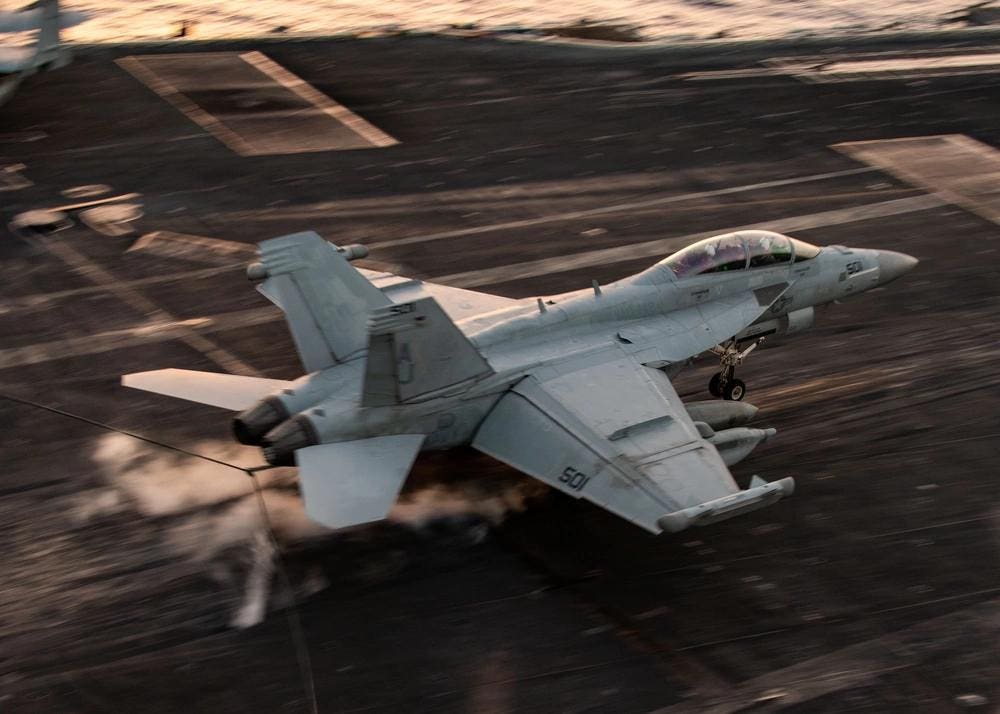A surprise winner in the latest Middle Eastern crisis is America’s massive USS Gerald R. Ford (CVN-78)-class aircraft carrier program. With the Pentagon showing no sign of pulling the lead ship back from an initial deployment, the Ford program’s biggest threat, a long-delayed make-or-break sortie generation test—determining just how many aircraft Ford-class carriers can sustain through a battle—is likely to face further delay, pressurizing a looming Congressional debate for more carriers.
Ford advocates are certainly happy. The October 7 attack on Israel transformed the nature of USS Gerald R. Ford’s first “real” deployment, pushing the carrier into the limelight. Engaged in a relatively sedate, port-call-heavy passage into the Western Mediterranean, the carrier shifted into crisis mode, abruptly canceling two port calls in Southern France and roaring east, where it has been enhancing U.S. command-and-control and situational awareness ever since.
The platform has been valuable enough that the Pentagon extended the Ford’s deployment twice since the initial attacks. As the ship, in its longest uninterrupted stint at sea yet, still orbits on the fringe of open conflict, Pentagon leaders may try and squeeze a few extra months out of what the Ford-class carrier Program Manager, Captain Brian Metcalf, previously described as an “at least six-month deployment.”
To Ford advocates, this newfound relevance is great news, as the high-tech aircraft carrier, to bend a phrase from The Hunt for Red October, “is no longer a research project.”
Put bluntly, the Hamas-Israel confrontation offers an ideal scenario for the USS Ford. Air threats are minimal, and the Middle East crisis seems unlikely, at this point, to demand the sustained, simultaneous utilization of the Ford’s entire carrier air wing—something that would likely stress the USS Ford’s still-buggy flight deck and, as yet, an under-optimized crew.
While demand for the carrier’s specialized brace of Northrop Grumman
NOC
The Ford isn’t quite there yet, but it is starting to look and act more like a fully-fledged aircraft carrier. According to every public metric, this lightly-crewed, $13.3 billion Nimitz-class remake is doing everything it needs to do. As a real-world demonstration of relevance, the Mideast crisis couldn’t have come at a better time. With four Ford-class carriers either in service, building or in early-stage procurement, U.S. carrier advocates are eager for any help in the big fight to keep the big-carrier production line humming.
While USS Ford’s teething problems obviously still exist, in public, the carrier is doing quite well. Instead of breaking down in some dramatic and embarrassingly public fashion, the USS Ford is getting positive headlines and quietly breaking operational records. That’s good. The ship needs a “win”, and, at a minimum, the carrier’s performance is enormous shift from a year ago, when the Ford crept back into Norfolk, returning from a somewhat unsatisfactory 53-day shakedown cruise two days after Thanksgiving.
But to really prove itself, the carrier just needs to pass a grueling endurance test, showing it can generate and sustain 30% more sorties than the legacy aircraft carriers it is meant to replace.
A Young Carrier Heads To Europe:
The Ford has come a long way this year. On May 2, as the USS Ford quietly departed the Navy’s Norfolk super-base, the carrier was, like many troubled young Americans before it, headed to Europe to avoid withering public scrutiny.
Early 2023 was a tough time for the Ford. In January 2023, the Pentagon’s testing agency hammered the carrier’s unreliable basic subsystems. With a negative GAO report on the way, and former carrier manager Rear Admiral James Downy likely facing Senate confirmation to be the next Navy shipbuilding boss as head of NAVSEA, the Navy was eager to get the long-troubled ship into an extended deployment, out of the crosshairs of both Congressional budget-cutters and Pentagon doubters.
For the ship, a relatively leisurely European tour offered a perfect refuge to iron out operational kinks, and, with Russia’s sad and increasingly decrepit grab-bag of naval forces still eager to prove their relevance, the deployment offered the crew some opportunity for both amusement and a little bit of manageable excitement.
Had Hamas not intervened, the veteran crew of the Ford was, upon their return, tapped to embark upon a complex sortie-generation test, finally proving the Navy’s Ford-class business case was valid—that a crew, notionally 20% smaller than the crew used to staff the Navy’s legacy Nimitz-class carriers, could pump out 30% more sorties than the older carriers.
But, with the attack on Israel, everything changed. Two port calls in Southern France were cancelled. Then the Pentagon began extending the Ford’s deployment, first on October 17 and followed by another extension a month later. Real world demands are pushing Ford’s crucial performance test farther and farther to the right.
A lot is riding on the Ford’s performance. If the carrier fails to beat legacy carrier sortie generation rates, the Navy will have a far harder time convincing the Pentagon, the Administration and the Congress to buy more of the $13.3 billion ships.
Pushing The Crew Into The Danger Zone:
The USS Gerald R. Ford is breaking new ground. With the attack on Israel, the six and a half-year-old USS Ford has finally started acting like a “real” aircraft carrier. After the attack, USS Ford’s defining operational characteristic—an odd tendency to avoid long stints at sea in favor of making a port call every few weeks—came to an abrupt halt. For the first time, the Ford and its crew demonstrated the ship wasn’t tied to a safe harbor, but is capable of serving as a flexible platform, handling surprise demands.
That is a big deal.
Unlike America’s other big carriers, the USS Ford has rarely been underway for more than 30 consecutive days. Before the carrier’s 2022 shakedown cruise—where the vessel only managed to chalk up a 24-day stretch of uninterrupted steaming—the ship had only been underway for more than thirty days once, in late 2020. Given the long-standing operational pattern, the carrier’s apparent lack of endurance suggested either that the relatively small crew was struggling, subsystems were failing, or both.
This operational deployment was no exception. Over the course of the current European trip, USS Ford settled into a relatively regular pattern of spending 3 to 4 weeks at sea, followed by a multi-day port call. In May, the carrier enjoyed a five-day port visit to Oslo, Norway. June was interrupted by a multi-day stayover in Spit, Croatia. Then, in July, the carrier spent four days in Piraeus, Greece, and the next month, the crew welcomed a stint at Antalya, Türkiye. In September, the ship moored for four days in Trieste, Italy.
The deployment was likely set to close out with triumphant visits to the big French ports of Marseille and Toulon, helping the French prepare for their high-tech future carrier project.
Rather than enjoy seven extended port calls over the course of a near six-month deployment, the Ford, now, is showing almost Nimitz-like performance. As of late November, the USS Ford has spent about two full months at sea—the longest uninterrupted stint at sea the 6.5-year-old ship has ever experienced.
If the current pattern holds, the Ford will match the pace of six port calls in eight months set in 2022-23 by the USS George H.W. Bush (CVN 77), the last carrier to spend a full deployment in European waters.
The True Test Is Dead Ahead:
Ultimately, the Ford-class value proposition rests on the ability of a small, efficient crew to keep their air wing in the air and fighting for as long as possible. With the carrier’s flight deck still struggling with reliability, training and personnel allocation issues, the Navy is, obviously, reluctant to put it to a high-profile test. But there’s a lot at stake—and the Ford-class program is feeling the heat.
It is great America’s newest carrier is performing and demonstrating value in a real-world scenario. But the ship’s current performance cannot push aside the fact that, as a new class of aircraft carrier, the platform has, so far, failed to meet a single metric the Navy publicly employed to justify the pricey platform. A hoped-for thirty percent reduction in operations and maintenance costs has slumped to barely half that. An over twenty-percent reduction in crew seems set to grow to within ten to fifteen percent of the legacy Nimitz class.
The sole business case metric that has remained unchanged over time is the Navy’s hoped-for 30% increase in sortie generation rates. As all the other metrics decayed, the Navy has held to this single statistic. But it hasn’t been tested. With the USS Ford on the precipice of war and China pushing more and more carriers into service, the time for NAVSEA dithering is over. Do the test.
For the Navy, it is simply time to put-up or shut-up.
The performance metrics the Ford-class carrier program must meet are clear and well-defined. Despite USS Gerald R. Ford’s strong performance in the Mediterranean, if the carrier, upon return from this current deployment, cannot generate the Navy’s stated goal of 160 sorties a day for 30 days, or is unable to sustain four 24-hour days of continuous 270 sorties a day, then there needs to be a real top-to-bottom reckoning at NAVSEA and throughout the Navy.
Read the full article here





